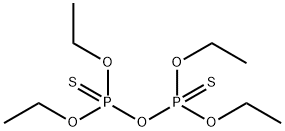
СУЛЬФОТЕП
- английское имяSULFOTEP
- CAS №3689-24-5
- CBNumberCB3489413
- ФормулаC8H20O5P2S2
- мольный вес322.31
- EINECS222-995-2
- номер MDLMFCD00026764
- файл Mol3689-24-5.mol
| Температура плавления | <25℃ |
| Температура кипения | bp2 136-139° |
| плотность | 1.2175 g/cm3 (20℃) |
| давление пара | 1.7 x 10-4 at 20 °C (Windholz et al., 1983) |
| показатель преломления | 1.5000 (589.3 nm 20℃) |
| Fp | -18 °C |
| температура хранения | APPROX 4°C |
| растворимость | Miscible with methyl chloride and most organic solvents (Worthing and Hance, 1991) |
| форма | Liquid |
| цвет | Clear colorless |
| Растворимость в воде | 30 mg/L at 20 °C (Worthing and Hance, 1991) |
| Мерк | 13,9056 |
| БРН | 1714019 |
| констант закона Генри | 2.88 at 20 °C (approximate - calculated from water solubility and vapor pressure) |
| Пределы воздействия | NIOSH REL: TWA 0.2 mg/m3, IDLH 10 mg/m3; ACGIH TLV: TWA 0.2 mg/m3. |
| Рейтинг продуктов питания EWG | 1-2 |
| FDA UNII | V41BK2EE8X |
| Система регистрации веществ EPA | Sulfotep (3689-24-5) |
| UNSPSC Code | 41116107 |
| NACRES | NA.24 |
| Коды опасности | T+,N,Xn,F |
| Заявления о рисках | 27/28-50/53-67-65-38-11 |
| Заявления о безопасности | 23-28-36/37-45-60-61-62 |
| РИДАДР | 1704 |
| OEB | C |
| OEL | TWA: 0.2 mg/m3 [skin] |
| WGK Германия | 3 |
| RTECS | XN4375000 |
| Класс опасности | 6.1(a) |
| Группа упаковки | II |
| кода HS | 29209090 |
| Банк данных об опасных веществах | 3689-24-5(Hazardous Substances Data) |
| Токсичность | LD50 s.c. in mice: 8 mg/kg (Holmstedt) |
| ИДЛА | 10 mg/m3 |
рисовальное письмо(GHS)
-
рисовальное письмо(GHS)


-
сигнальный язык
опасность
-
вредная бумага
H300+H310+H330:Смертельно при проглатывании, при контакте с кожей или при вдыхании.
H410:Чрезвычайно токсично для водных организмов с долгосрочными последствиями.
-
оператор предупредительных мер
P260:Не вдыхать газ/ пары/ пыль/ аэрозоли/ дым/ туман.
P262:Избегать попадания в глаза, на кожу или одежду.
P273:Избегать попадания в окружающую среду.
P280:Использовать перчатки/ средства защиты глаз/ лица.
P302+P352+P310:ПРИ ПОПАДАНИИ НА КОЖУ: Промыть большим количеством воды. Немедленно обратиться за медицинской помощью.
P304+P340+P310:ПРИ ВДЫХАНИИ: Свежий воздух, покой. Немедленно обратиться за медицинской помощью.
СУЛЬФОТЕП химические свойства, назначение, производство
Химические свойства
Sulfotep is a yellow mobile liquid. Garliclike odor.Использование
Sulfotep is used to control aphids, thrips, mites and whiteflies in glasshouses by fumigation. It also used to control sciarid and phorid flies in mushrooms.Общее описание
Tetraethyl dithiopyrophosphate and compressed gas mixture is a liquid charged with a gas. Tetraethyl dithiopyrophosphate is a yellow liquid. Its vapor is heavier than air. SULFOTEP is lethal by skin absorption and inhalation. Prolonged exposure of the containers to fire or heat may result in their violent rupturing and rocketing.Профиль реактивности
Organothiophosphates, such as TETRAETHYL DITHIOPYROPHOSPHATE, are susceptible to formation of highly toxic and flammable phosphine gas in the presence of strong reducing agents such as hydrides. Partial oxidation by oxidizing agents may result in the release of toxic phosphorus oxides. SULFOTEP is incompatible with the following: Strong oxidizers, iron [Note: Corrosive to iron.] .Опасность
Toxic by ingestion, inhalation, and skin absorption; cholinesterase inhibitor; use may be restricted. Questionable carcinogen.Профиль безопасности
Poison by ingestion, skin contact, inhalation, intramuscular, intraperitoneal, subcutaneous, and intravenous routes. A cholinesterase inhbitor type of insecticide. When heated to decomposition it emits toxic fumes of POx and SOx. See also PARATHION.Возможный контакт
Sulfotep is used in greenhouse fumigant formulations for control of aphids, spider mites; thrips, whiteflies, etc.Экологическая судьба
Soil. Cleavage of the molecule yields diethyl phosphate, monoethyl phosphate and phosphoric acid (Hartley and Kidd, 1987).Chemical/Physical. Emits toxic oxides of sulfur and phosphorus oxides when heated to decomposition (Lewis, 1990).
Метаболический путь
Sulfotep and related compounds may be formed photochemically from a number of phosphorodithioate and phosphorothioate insecticides including azinphos-methyl, chlorpyrifos, malathion, methidathion and phosalone (Abdelbagi and Gaston, 1998). Since sulfotep has a rather high mammalian toxicity, this may be of some toxicological sigruficance. Sulfotep is transformed in the environment via oxidative desulfuration to the highly active anti-cholinesterase compounds monosulfotep and tetraethyl pyrophosphate. It is deactivated by hydrolysis to O,O-diethyl phosphorothioate and diethyl phosphate.Перевозки
UN1704 (Sulfotep) Tetraethyl dithiopyrophosphate, Hazard Class: 6.1; Labels: 6.1-Poisonous materials.Несовместимости
Incompatible with oxidizers (chlorates, nitrates, peroxides, permanganates, perchlorates, chlorine,bromine, fluorine, etc.); contact may cause fires or explosions. Keep away from alkaline materials, strong bases, strong acids, oxoacids, epoxides. Hydrolyzes very slowly in aqueous solution. Attacks some forms of plastic, rubber and coating. Corrosive to iron.Утилизация отходов
Consult with environmental regulatory agencies for guidance on acceptable disposal practices. Generators of waste containing this contaminant (≥100 kg/mo) must conform with EPA regulations governing storage, transportation, treatment, and waste disposal. In accordance with 40CFR165, follow recommendations for the disposal of pesticides and pesticide containers. Must be disposed properly by following package label directions or by contacting your local or federal environmental control agency, or by contacting your regional EPA office. Incineration with added flammable solvent in furnace equipped with afterburner and alkaline scrubber.